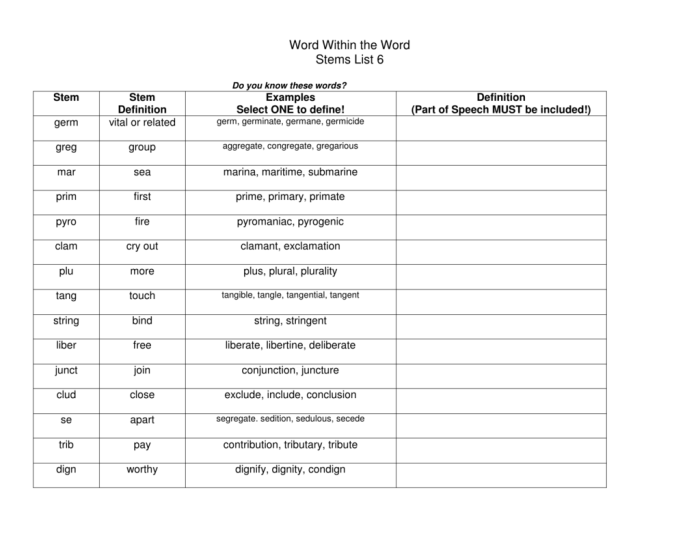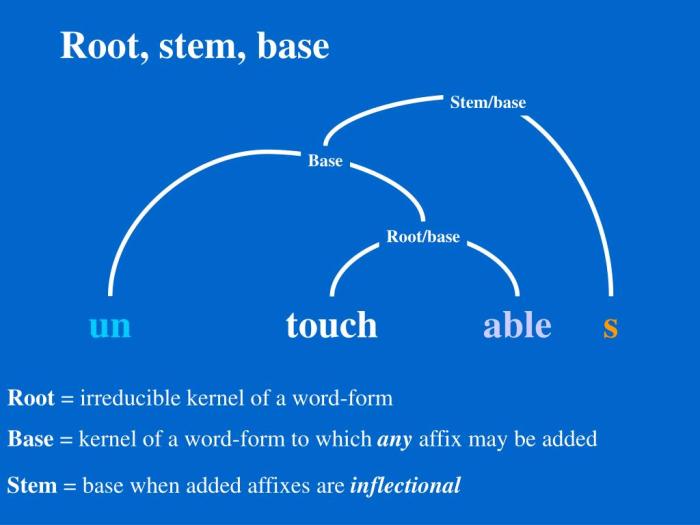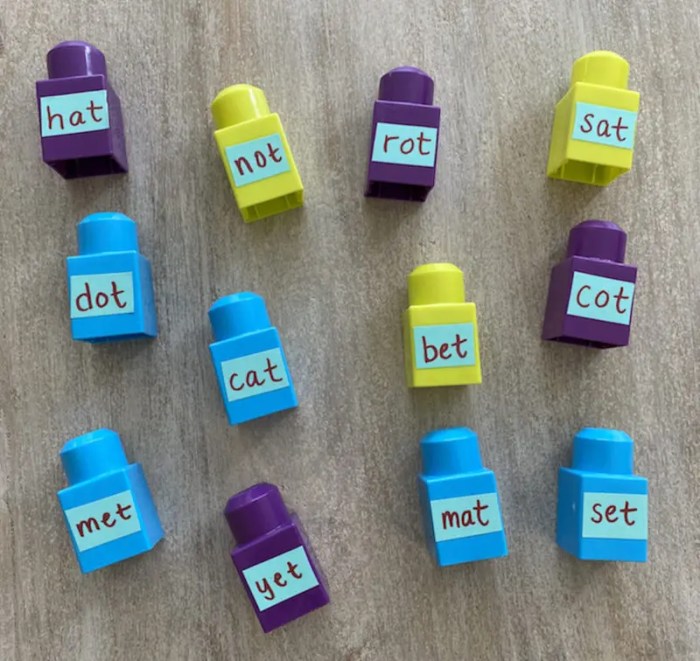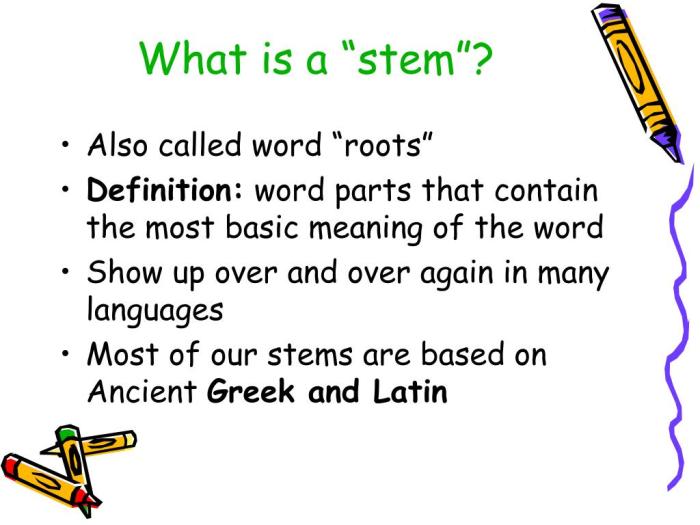Words with the stem leg embark us on a captivating linguistic journey, revealing their etymological roots, morphological variations, and semantic nuances.
Delving into the Indo-European origins of the stem leg, we trace its evolution across languages, uncovering cognates that share its essence.
Words with the Stem Leg

Definitions
In linguistics, a stem is a base word or root from which other words can be formed by adding prefixes or suffixes. The stem leg refers to the part of a word that remains after all prefixes and suffixes have been removed.
For example, in the word “legless”, the stem is “leg”.Words with the stem leg typically refer to something related to the leg or its functions. These words can be nouns, verbs, adjectives, or adverbs.
- Nouns:leg, legging, leggy
- Verbs:leg it, leg up
- Adjectives:leggy, legless
- Adverbs:legily
Etymology of the Stem Leg

The stem leg, with its ubiquitous presence in languages across the globe, traces its etymological roots to the depths of Indo-European history. Delving into its origins, we uncover a captivating tale of linguistic evolution and the interconnectedness of human tongues.
Indo-European Roots
The stem leg finds its genesis in the Proto-Indo-European (PIE) root -leg-, signifying ‘leg’ or ‘limb.’ This root, like an ancient seed, germinated and spread across the Indo-European language family, giving rise to a multitude of cognates in diverse languages.
In Sanskrit, the cognate पाद (pāda) signifies ‘foot’ or ‘leg.’ In Greek, the root manifests as πούς (poús), meaning ‘foot.’ Delving into the Germanic branch, we encounter the Old English word lēg, the precursor to the modern English ‘leg.’ These cognates, though separated by time and space, bear witness to the shared etymological heritage that unites Indo-European languages.
Morphological Variations of the Stem Leg

The stem leg undergoes several morphological variations to form different words. These variations are primarily influenced by the grammatical function and context of the word.
Stem Variation
The stem leg exhibits three main morphological variations: leg-, legi-, and legum-.
- leg-: This is the basic form of the stem and is used in nouns and adjectives, such as leg, leggy.
- legi-: This variation is used in verbs, such as legitimate, legislate.
- legum-: This variation is used in nouns, such as legumen, leguminous.
Usage Rules
The following rules govern the usage of each variation:
- leg-is used when the word is a noun or an adjective.
- legi-is used when the word is a verb.
- legum-is used when the word is a noun referring to a plant or its products.
| Variation | Usage | Examples |
|---|---|---|
| leg- | Nouns and adjectives | leg, leggy |
| legi- | Verbs | legitimate, legislate |
| legum- | Nouns (plants or products) | legumen, leguminous |
Semantic Range of Words with the Stem Leg

The stem leg possesses a diverse semantic range, encompassing various meanings associated with the act of “gathering,” “choosing,” and “reading.” These meanings manifest in a multitude of words derived from the stem leg, each carrying a distinct shade of significance.
Gathering
- Legible:Capable of being read or understood.
- Collect:To gather or bring together into one place.
- Delegate:To entrust (a task or responsibility) to another person, typically one with less authority.
Choosing
- Eligible:Meeting the requirements or qualifications for something.
- Select:To choose or pick out from a group.
- Elect:To choose or vote for someone to hold a position or office.
Reading
- Lecture:A formal talk given to a group of people, typically on a specific subject.
- Legend:A traditional story or tale that is passed down from generation to generation.
- Legacy:Something that is handed down from the past or from one person to another.
Words with the Stem Leg in Literature

Words with the stem leg are frequently employed in literature to convey a range of meanings and create specific effects. Authors utilize these words to describe physical attributes, express emotions, or evoke imagery related to movement and support.
The stem leg can symbolize strength, stability, and determination. In J.R.R. Tolkien’s The Lord of the Rings, the character Aragorn is described as having “long legs that could stride over leagues.”
Legs as Metaphors
Authors may also use the stem leg metaphorically to represent a person’s journey or life path. In Toni Morrison’s Beloved, the character Sethe’s legs are described as “tree trunks,” suggesting her resilience and strength in the face of adversity.
Legs as Symbol of Weakness
Conversely, weak or injured legs can symbolize vulnerability, dependence, or a sense of being trapped. In Alice Walker’s The Color Purple, the character Celie is physically abused by her husband, and her legs are often described as “hurting” or “aching.”
Legs as Objects of Desire
In some literary works, legs are depicted as objects of desire or beauty. In Vladimir Nabokov’s Lolita, the narrator Humbert Humbert becomes obsessed with the young girl Dolores Haze’s “slender, white legs.”
Words with the Stem Leg in Linguistics

Words with the stem leg play a significant role in linguistic analysis. Linguists utilize these words to delve into the intricate structure and evolutionary trajectory of languages. By examining the morphological variations and semantic range of words with the stem leg, linguists gain insights into how languages evolve and change over time.
Morphological Variations of Words with the Stem Leg
The morphological variations of words with the stem leg provide valuable information about the historical development of a language. Linguists analyze the different forms of these words, such as the addition of suffixes or prefixes, to trace the evolution of their meaning and usage.
For instance, the word “leg” can be modified to form “leggy,” “legless,” or “legitimate,” each with distinct meanings and grammatical functions.
Semantic Range of Words with the Stem Leg
The semantic range of words with the stem leg offers insights into the cognitive processes involved in language comprehension. By examining the various meanings associated with these words, linguists can explore how humans categorize and conceptualize their experiences. For example, the word “leg” can refer to a physical body part, a supporting structure, or a metaphorical concept, demonstrating the multifaceted nature of human cognition.
Words with the Stem Leg in Linguistic Research
Words with the stem leg have been extensively used in linguistic research. Linguists have employed these words to study various aspects of language, including:
- Historical linguistics:Tracing the evolution of words and their meanings over time.
- Cognitive linguistics:Exploring the relationship between language and thought.
- Sociolinguistics:Investigating the influence of social factors on language use.
Words with the Stem Leg in Education
In educational contexts, words with the stem leg play a significant role in enhancing vocabulary and improving reading comprehension. These words are found in various academic disciplines, including science, history, and literature.
Exploring words with the stem leg, like ‘leggy’ and ‘legless’, leads us to unit 6 session 2 letrs . This session delves into the intricacies of letter combinations and their pronunciations. Returning to our stem, we can further analyze ‘legibility’ and ‘legendary’, uncovering the nuances of language and its written form.
Teachers can incorporate words with the stem leg into their lessons to expand students’ vocabulary and develop their understanding of complex concepts. By exploring the etymology, morphological variations, and semantic range of these words, students can gain a deeper appreciation for the nuances of language.
Using Words with the Stem Leg to Enhance Vocabulary
- Introduce root words:Begin by introducing students to the root word leg, explaining its meaning and providing examples of words that contain it.
- Explore prefixes and suffixes:Discuss how prefixes and suffixes can change the meaning of root words. For example, the prefix “pro” means “forward” and can be added to leg to form “proleg,” which refers to a leg-like structure in insects.
- Create word webs:Have students create word webs to connect words with the stem leg. This activity helps them visualize the relationships between words and expand their vocabulary.
Using Words with the Stem Leg to Improve Reading Comprehension
- Identify key vocabulary:Before students read a text, identify key words with the stem leg and discuss their meanings. This helps them understand the main concepts of the text.
- Use context clues:Encourage students to use context clues to determine the meaning of unfamiliar words with the stem leg. This develops their critical thinking skills.
- Analyze word usage:Ask students to analyze how words with the stem leg are used in different contexts. This helps them understand the nuances of language and improves their writing skills.
Words with the Stem Leg in Cross-Cultural Communication
Words with the stem leg can carry different meanings and connotations across cultures. This can lead to misunderstandings or misinterpretations in cross-cultural communication.
For example, in English, the word “leg” can refer to the lower limb of a human or animal, or to a support or base of an object. However, in some other languages, the word for “leg” may only refer to the human leg, or it may have a more specific meaning, such as “thigh” or “calf”.
Misunderstandings Due to Cultural Differences
These differences in meaning can lead to misunderstandings. For example, a person from a culture where the word for “leg” only refers to the human leg may be confused if they hear someone from another culture talking about the “leg” of a table.
FAQs
What is the definition of a stem leg in linguistics?
A stem leg is a morphological unit that forms the core of a word, carrying its basic meaning and grammatical properties.
How do words with the stem leg contribute to language evolution?
They provide evidence of language relationships, allowing linguists to trace the historical development of languages.
Can words with the stem leg have multiple meanings?
Yes, the stem leg can carry different semantic nuances, depending on its context and morphological variations.
